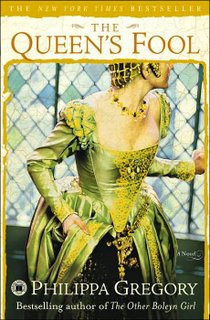 written by Philippa Gregory
written by Philippa GregoryI'm not usually one to read sequels or go on a book-series jag, but since I enjoyed The Other Boleyn Girl and had the next of Gregory's books on hand, I figured I'd pick it up. The Queen's Fool takes a little different approach to historical fiction, and I like it. Unlike in The Other Boleyn Girl, the main character, Hannah Verde, is completely fictitious, and she tells quite a story of her own. Along the way, she gets you into the court and you experience the dramatic turbulence of Queen Mary's reign, from her rise to power to her heartbroken end.
Hannah is a young Jewish girl who has fled to England from Spain with her father. While working in her father's printing business, she is noticed by Robert Dudley, a dashing and iconic court figure. Dudley brings Hannah to the court as a "holy fool" because Hannah has the gift of "sight" — a prophetic leaning which sometimes reveals to her future events or truths.
A little background to fill in the gap between the end of The Other Boleyn Girl and the beginning of The Queen's Fool: when Hannah comes to court, King Edward is on the throne. He is Henry VIII's only son and, too young and too sickly to rule the country, he is cared for and advised by protectors and counselors, of which Dudley's father is one. Edward's two half-sisters are Princess Mary — daughter of Queen Catherine, who Henry divorced in order to marry Ann Boleyn — and Princess Elizabeth — daughter of Ann Boleyn.
Hannah quickly gets caught up in a variety of toxic rivalries. She swoons over Dudley even while promised in marriage to a respectable Jewish boy of her father's choosing. She works as a spy for Dudley even while serving Queen Mary with devoted adoration. She later cares for Princess Elizabeth even though the princess is in a fierce battle with Mary for the throne and the heart of England.
Really cool elements:
- Knowing that the main character was decidedly fictitious, I felt less distracted by whether the book was historically accurate or not. I guess knowing that there's lots of fabrication freed me up a bit to just enjoy the story.
- Gregory keeps many plots going at once, but never so many that you get confused or lose interest. The book is surprisingly readable, considering the slew of characters and how much is going on among them. Being a romantic, I especially liked the story of Hannah's initial rejection of Daniel (her betrothed) and the way their relationship changes over the years into one of tolerance, then admiration and respect, and then beautiful, faithful love. And I liked how their story contrasts so starkly with the way love and relationships are portrayed among the royals.
- Though you can read this book and enjoy it without first reading The Other Boleyn Girl, I'm glad I read the two books in succession, because I liked how Gregory builds the character of Elizabeth to so strongly reflect Elizabeth's mother, Ann Boleyn. There's also a strong theme of sisterly rivalry that carries through both books, and I liked that too.
- The book does a great job of bringing out the fact that our allegiances and affections are often paradoxical. I appreciate that portrayal, because I think all of us are riddled with paradox — at least I know I am! For example, observing Hannah's admiration of Queen Mary, I'm reminded that it's possible to be a virtuous, powerful, gracious person (like Mary) on one hand — but on the other hand commit atrocious, hurtful, damaging acts of barbarism (also like Mary). And watching Hannah's volatile affections first for Lord Robert and later for Daniel, I'm reminded how I too seek independence and empowerment in my relationships — yet at the same time I expect to be cared for and protected.
Not-so-cool elements:
- Hannah's character was an awful lot like Mary Boleyn in Gregory's last book. Other than that, the only thing that was a little bothersome was that this novel wasn't so quick a read as The Other Boleyn Girl. In fact, I wasn't totally hooked till about the halfway point. Then it became hard to put down.



